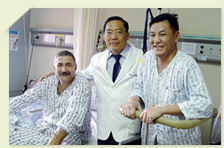 Your spine is made up of 51 bones, which are connected through joints. If
there is a problem in one of those bones, you will feel pain in your spine. The
most common spinal disease called spinal disc herniation is a medical condition
where discs which normally act as shock absorbers between the bones in your
spinal column, press on nerves and cause discomfort. The second most common
disease, scoliosis, is a condition in which the spine bends to the side
abnormally due to poor posture. Beside these diseases, you can feel pain in your
spine due to several causes such as muscle pain, degenerative arthritis and
spinal stenosis or spondylolysis. Once you feel pain, you need to visit a doctor
without delay. If you put off the back pain as muscle pain and take pain
relievers, it is already too late when you visit a doctor once the pain gets
worse.
Your spine is made up of 51 bones, which are connected through joints. If
there is a problem in one of those bones, you will feel pain in your spine. The
most common spinal disease called spinal disc herniation is a medical condition
where discs which normally act as shock absorbers between the bones in your
spinal column, press on nerves and cause discomfort. The second most common
disease, scoliosis, is a condition in which the spine bends to the side
abnormally due to poor posture. Beside these diseases, you can feel pain in your
spine due to several causes such as muscle pain, degenerative arthritis and
spinal stenosis or spondylolysis. Once you feel pain, you need to visit a doctor
without delay. If you put off the back pain as muscle pain and take pain
relievers, it is already too late when you visit a doctor once the pain gets
worse. Spine surgery is a major operation that cuts the skin and muscle and shaves bones. As a result, it requires a long period for recovery and some side effects can occur. Unlike other surgical operations, a successful spine surgery does not mean the patient is 100% cured and requires continuous consultations with doctors and post-op management. Spine hospitals in Korea recommend procedures that promise a fast recovery and no side effects. One of such procedures is the Minimally Invasive Spine Surgery (MISS) which preserves normal tissue as much as possible while treating the affected parts with minimum incisions. As a result, patients can expect a fast recovery with no side effects. Another procedure called neuroplasty alleviates pain by injecting drugs directly into the spine and hospitalization is not necessary.
 Dr. Robert A Wells, a specialist in emergency and family medicine in the U.K.
received an examination in a neurosurgery ward in 2004 due to neck and arm pain.
He was given a shocking diagnosis that his condition was so bad that surgery was
required, which could lead to paralysis from his neck down. He refused to get
the surgery at first. However, as the pain got worse, he sought various methods
and was recommended to undergo the MISS procedure at Wooridul Spine Hospital in
Korea. At first, he hesitated to get treated there because he knew little about
Korea. He had doubts whether a Korean hospital can treat him when he could not
be treated in the U.K, a country with advanced medical technology. Then, an
article about microscopic laser discectomy developed by Dr. Sang-ho Lee’s team
at Wooridul Spine Hospital compelled him to come to Korea. According to the
article, the procedure was very successful in treating the spinal disease
without causing waist-down paralysis. In August 2004, Dr. Wells visited Korea to
get an examination. The condition in his disc and spine was so severe that the
MISS was not appropriate for him. So, he received another procedure.
Fortunately, the surgery was successful and the pain in his arms subsided.
Dr. Robert A Wells, a specialist in emergency and family medicine in the U.K.
received an examination in a neurosurgery ward in 2004 due to neck and arm pain.
He was given a shocking diagnosis that his condition was so bad that surgery was
required, which could lead to paralysis from his neck down. He refused to get
the surgery at first. However, as the pain got worse, he sought various methods
and was recommended to undergo the MISS procedure at Wooridul Spine Hospital in
Korea. At first, he hesitated to get treated there because he knew little about
Korea. He had doubts whether a Korean hospital can treat him when he could not
be treated in the U.K, a country with advanced medical technology. Then, an
article about microscopic laser discectomy developed by Dr. Sang-ho Lee’s team
at Wooridul Spine Hospital compelled him to come to Korea. According to the
article, the procedure was very successful in treating the spinal disease
without causing waist-down paralysis. In August 2004, Dr. Wells visited Korea to
get an examination. The condition in his disc and spine was so severe that the
MISS was not appropriate for him. So, he received another procedure.
Fortunately, the surgery was successful and the pain in his arms subsided.
After coming back to the U.K., his recovered fast. However, he felt pain in his thoracic vertebrae again in 2007. This time, he visited Korea right away and was diagnosed with disc protrusion. He received a discoplasty with the MISS procedure using an endoscope and laser. After the procedure, his pain subsided and he regained mobility in his arms.
Dr. Wells was a severely-ill patient who could have been paralyzed from his neck down. He admitted that “I was deeply impressed by Korea’s medical technology. I am a doctor in the U.K., a place where we have advanced medical technology. So, I have never imagined that I would get treated in Korea. I learned that there is a lot I don’t know.” He also claimed he was moved by Korean culture and hospitality during his stay in the hospital for surgery. He gave a big smile, saying that he would like to visit Korea one day for pleasure instead of treatment.
 Wooridul Spine Hospital is a specialized spine hospital that has been
treating patients with spinal diseases for over 30 years. The hospital performs
20,000 surgeries and 60,000 minimally invasive treatments a year. The hospital
has branches in Seoul, Busan and other 4 regions in Korea and opened hospitals
overseas in Shanghai, Jakarta, Dubai and Istanbul. The Wooridul International
Patient Center (WIPC) offers a VIP lounge and a 1:1 escort service for
international patients.
Wooridul Spine Hospital is a specialized spine hospital that has been
treating patients with spinal diseases for over 30 years. The hospital performs
20,000 surgeries and 60,000 minimally invasive treatments a year. The hospital
has branches in Seoul, Busan and other 4 regions in Korea and opened hospitals
overseas in Shanghai, Jakarta, Dubai and Istanbul. The Wooridul International
Patient Center (WIPC) offers a VIP lounge and a 1:1 escort service for
international patients. Kossenko Dmitri (aged 44, male) is a veteran and works in the wood working
industry in Irkutsk, Central Siberia. He fell about 5 meters down at a pool
construction site on the first day of 2011. As a result, he suffered a fracture
of his right hip joint and underwent surgery at a hospital in Irkutsk on the
next day. However, he could not completely recover from the injury. So, he
underwent another surgery next May, but his hip joint clicked as he moved and
his two legs were of differing lengths.
Kossenko Dmitri (aged 44, male) is a veteran and works in the wood working
industry in Irkutsk, Central Siberia. He fell about 5 meters down at a pool
construction site on the first day of 2011. As a result, he suffered a fracture
of his right hip joint and underwent surgery at a hospital in Irkutsk on the
next day. However, he could not completely recover from the injury. So, he
underwent another surgery next May, but his hip joint clicked as he moved and
his two legs were of differing lengths. While he was so concerned about his condition, he watched a TV program on hip joint surgery at Chonnam National University Hwasun Hospital and visited Korea. He was closely examined at the hospital and underwent surgery. After the surgery the clicking sound of his joint disappeared and the lengths of his legs returned to normal. Mr. Dmitri said that “I went to hospitals here and there in Russia, but they were not as kind as the nurses at Chonnam National University Hwasun Hospital. I am deeply touched by Korea’s excellent medical technology and service.”
In the next bed over from Mr. Dmitri, Oyun Namjil (aged 47, male), a surgeon in a Mongolian armed forces hospital was hospitalized. He was suffering from avascular necrosis that could take his life due to an interruption of the blood supply to his hip joints. He underwent surgery at a trauma center in Mongolia in 2010, but he still did not get better.
Mr. Namjil who was in active service as a lieutenant major was informed of Chonnam National University Hwasun Hospital by Colonel Menjila who underwent surgery at the hospital. Mr. Namjil visited Korea without hesitation. He said that “I spent two miserable years as my feet did not move outward. But, my hip joints were cured after getting surgery at Chonnam National University Hwasun Hospital. I am satisfied with the results.”
 Chonnam National University Hwasun Hospital Joint Center treated 81 patients
from 16 countries in 2011 alone. It is famous for its excellent techniques in
conducting surgery on patients whose previous surgery in their home country
failed. The Joint Center consists of a knee joint clinic, a hip joint clinic and
spine and general orthopedics. Many medical practitioners visited the Center
from abroad to learn about its world-class medical technology.
Chonnam National University Hwasun Hospital Joint Center treated 81 patients
from 16 countries in 2011 alone. It is famous for its excellent techniques in
conducting surgery on patients whose previous surgery in their home country
failed. The Joint Center consists of a knee joint clinic, a hip joint clinic and
spine and general orthopedics. Many medical practitioners visited the Center
from abroad to learn about its world-class medical technology.  To have a healthy spine, you need to maintain a healthy lifestyle. When you
study or work on the computer for a long time, you should take a 10-minute break
each hour and stretch. Further,, when you sleep, it is best if you place a
pillow under your calves or between them.
To have a healthy spine, you need to maintain a healthy lifestyle. When you
study or work on the computer for a long time, you should take a 10-minute break
each hour and stretch. Further,, when you sleep, it is best if you place a
pillow under your calves or between them. Walking is the best exercise for your spine. Walking on dirt roads or lawns is better than on asphalt or concrete and sneakers or shoes with cushions are recommended. The Jeju Olle walking paths is the representative trail in Korea where you can discover the beauty of Jeju Island, designated UNESCO's World Natural Heritage. Though Olle trails are comparable to the Camino de Santiago, you will see a neat and ever-changing landscape. As there are over 400 guest houses and traditional markets near the Olle trails, visitors do not need to worry about accommodations or food.
Features of Korean Medical Services
Medical Korea becomes another name of Korea with its world-renowned medical doctors, advanced medical equipment, development of new treatments.
- Korea ranks Asia’s best in international medical journal publication.
- Korea is one of the top countries for the clinical trial cases in the world.
- Korea’s competitiveness in the treatment of cancers, cardiac and vascular diseases, spinal disc and organ transplantation belongs to the world’s top tier.
-Korea is considered a world leader in cosmetic surgery, dermatology, and dentistry fields.
- Korea is one of the top countries for the clinical trial cases in the world.
- Korea’s competitiveness in the treatment of cancers, cardiac and vascular diseases, spinal disc and organ transplantation belongs to the world’s top tier.
-Korea is considered a world leader in cosmetic surgery, dermatology, and dentistry fields.
Medical Korea becomes another name of Korea with its world-renowned medical doctors, advanced medical equipment, development of new treatments.
In Asia, Korea is one of the most advanced countries in healthcare. The number of publications in medical science has been outstanding over the years. Around the globe, the largest number of clinical trials is carried out in Korea. Numerous international community services are performed, including the staff training program for doctors in developing countries, and Korea-funded projects aimed to help developing countries build modern facilities with ODA funds. It is our belief that Korea has the capabilities to serve international patients who are looking for top quality treatment at an affordable cost.
World-class healthcare services accompanied by highly advanced facilities and cutting-edge technology. The top-quality of care provided is monitored continuously by the government through hospital accreditation and strict evaluation programs. All general hospitals in Korea are not-for-profit organizations. Therefore, patient’s safety and satisfaction comes first rather than profitability. International medical societies highly respect our physicians, specialists, and surgeons.
The overall price is only 20-30% of the cost in the US. The price is less expensive than international hospitals in China and similar to the price of private hospitals in Singapore. No matter the cost, the quality of care provided will satisfy everyone’s needs.
[E-mail : mediaim@naver.com]
South Korea Medical discount site - Up to 20%http://www.koreakoreakorea.com











댓글 없음:
댓글 쓰기